The team and I get plenty of emails from readers of this site asking us to look at their Satsuma Pottery and tell them the value, the history and anything about it we can.
The only problem is, that 80% of these messages are met with the same reply:
"I'm sorry to say that this piece is not a real Satsuma antique, it is a mass-produced copy, probably not even made in Japan"
Being able to determine which item is real and which is a copy or fake is not an easy task. You will need to be able to find the marking on the item and confirm that it is the real deal and not a copy.
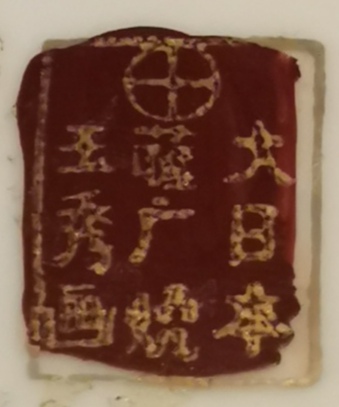
Check what language is written on your Satsuma
A great rule of thumb is to remember that all original pieces made in the Satsuma region of Japan do not have any English words on them. The artists and makers always signed the pieces with their names and often the word Satsuma, but never in English. They also commonly show the image associated with the emperor of the time, a circle with a cross through it.
So remember, if you are looking at purchasing a Satsuma Vase or something similar, turn it over and look at the marking on the bottom
These are some examples of fake satsuma markings that our readers have sent in. They don't all have to use English writing in. You can see that some look "stamped" or printed rather than hand-painted.
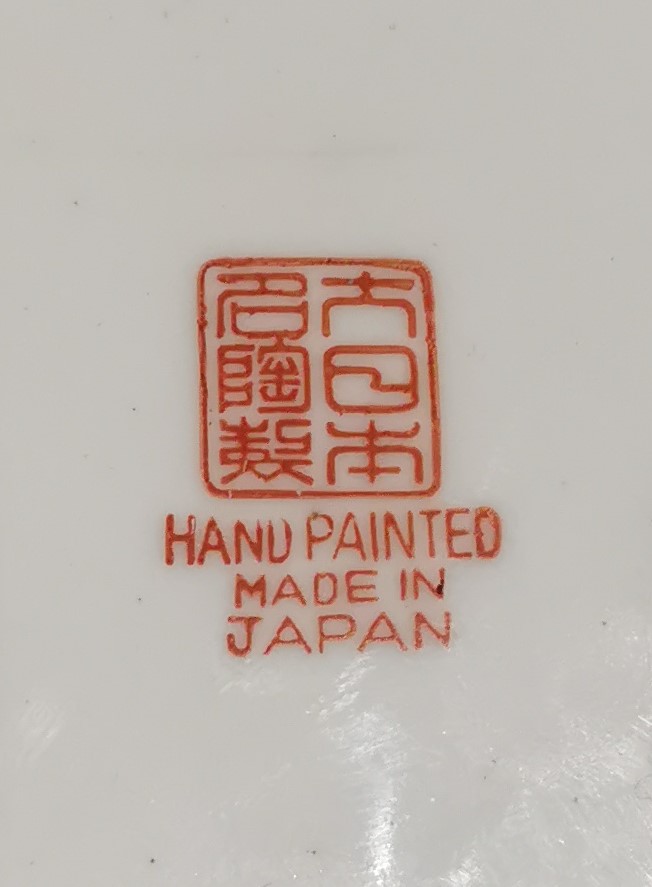
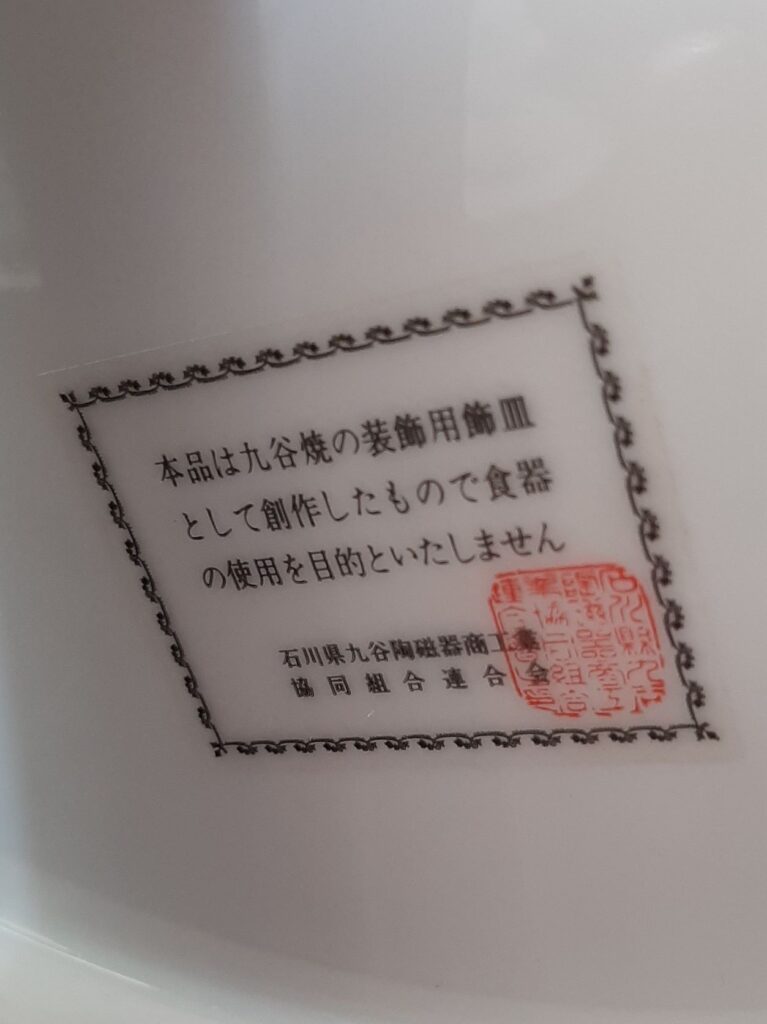
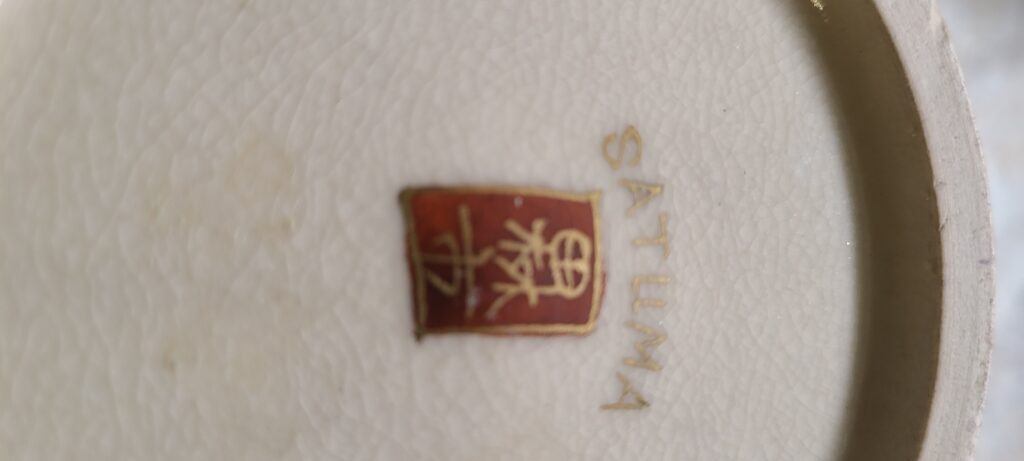
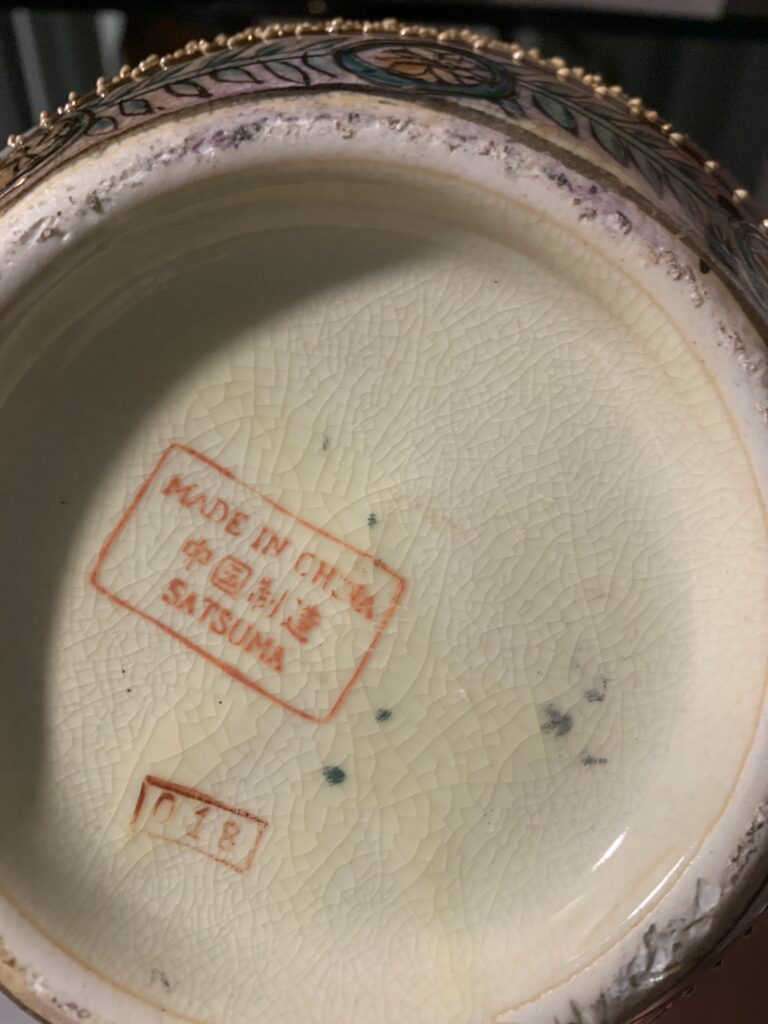
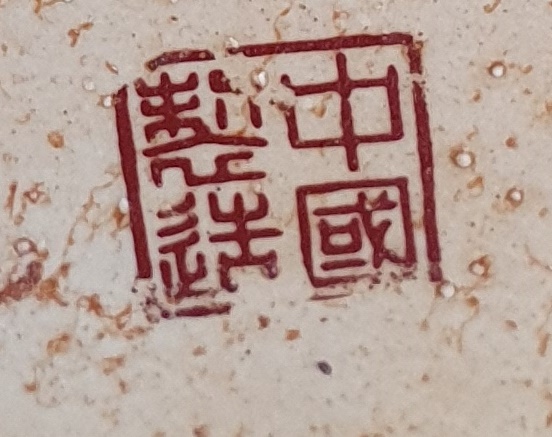
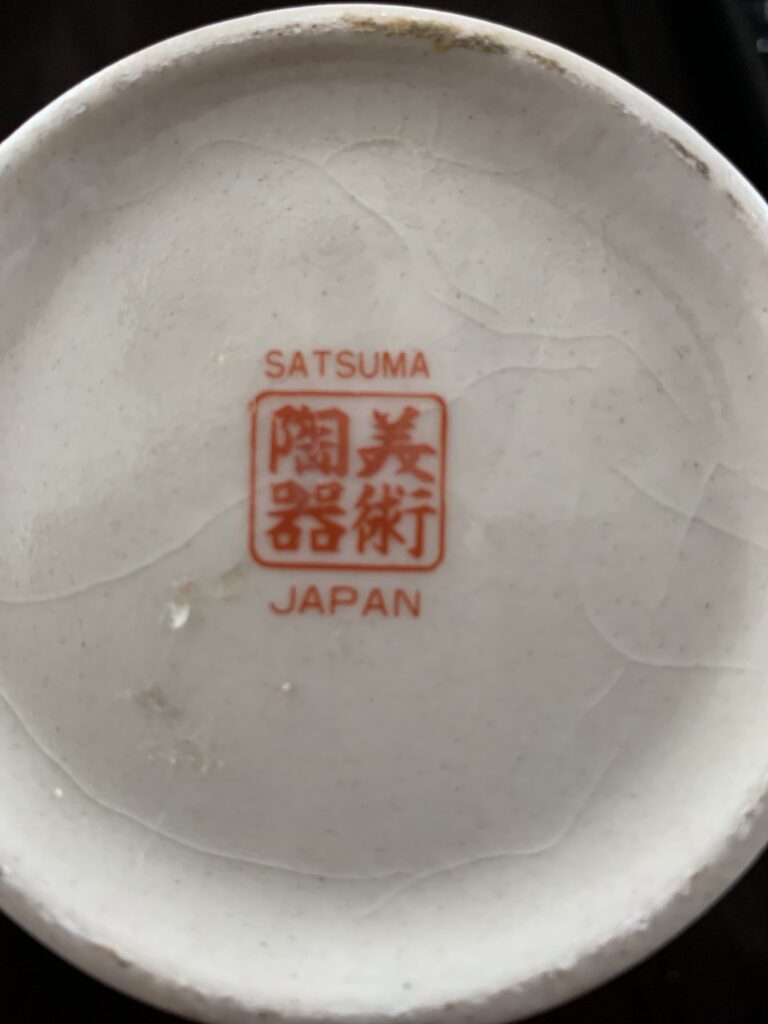
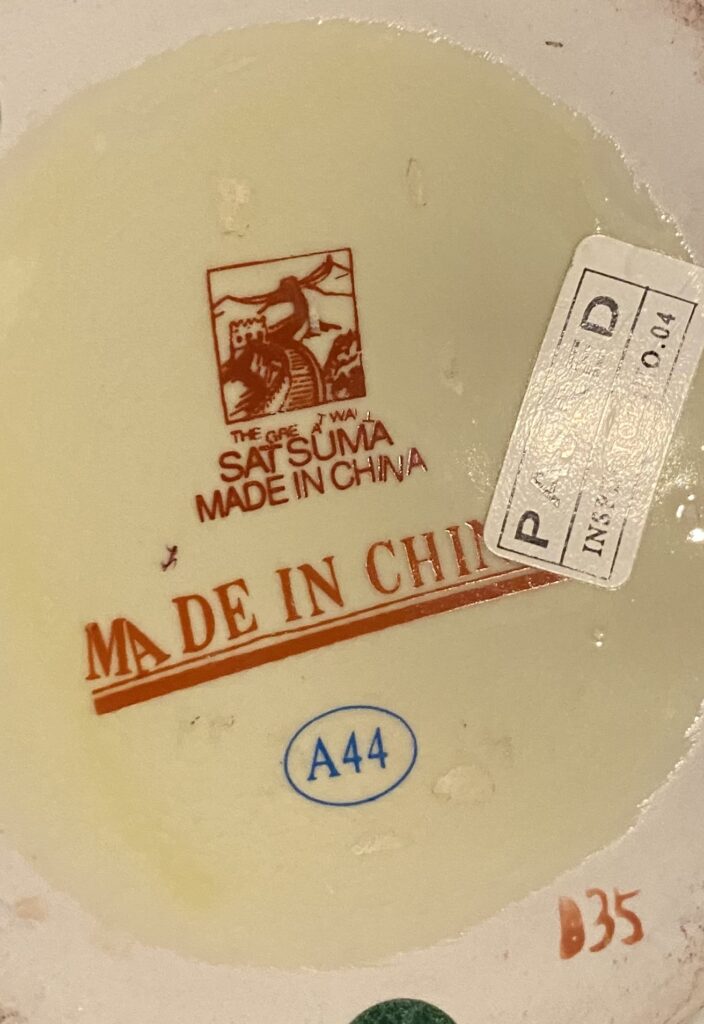
You will also need to remember to look for the crackled glaze and the off white or creamy coloring of the pottery underneath. The images are also important too and you should look for traditional Japanese people such as Geisha girls, immortals or plants and animals. Anything contemporary will show that the piece is a copy.
Satsuma with no markings on - are they fake too?
If your Satsuma piece has no markings on at all, then it will be harder to prove it is a genuine antique. You will have to resort to checking the quality of the painting, the "ring" of the porcelain and check the provenance of the item.
In my experience, I haven't seen many valuable antique pieces of Satsuma that don't have markings on. So if you think you have something worth money, get it checked by a reputable antique dealer in your area.
Do you have any tips for our readers on spotting fakes or copies of Satsuma Pottery?
You might also be interested in our list of books to help you find out about the Satsuma markings.
213 replies on “Are You A Satsuma Pottery Expert? Or How To Spot A Fake”
Pls help me I have these vases I don’t know if they are the real deal no mark nothing
Hello! I found this cigar ashtray that definitely looks old but is marked in blue “Royal Satsuma Nippon” accompanied with the cross in circle symbol. I know the rule is that English is not used during the same era as Nippon was but there are several places that say that this mark is the exception to the rule. What do you think? Thanks so much! JB
Royal Satsuma is a more modern style of design, usually British. So no, not an original antique.
Is this genuine
No, this is a mass-produced item – definitely not an antique.
Only worth what you would pay if you think it looks nice.
Hi, is this a fake? marking on the bottom of my Vase. Any help would be greatly appreciated
No, this looks like a genuine marking.
Hi, would you please let me know if this unmarked plate might be Satsuma? Thank you so much for your help!
Any insight would be much appreciated! Thank you!
Hello, could you please tell me whether or not this piece is a real Satsuma? Thanks!
Not a marking I have seen before. Try the resources at the bottom of this page to try to track it down: https://www.satsuma-pottery.com/is-my-satsuma-pottery-genuine
Thank you!
Unlikely an original antique. The marking looks stamped rather than hand painted
Hello, I have a little satsuma style tripod box, wondering if you could help me understand what the markings are ?
9” tall footed and lidded jar. Was a gift to missionary/teacher Lida B Smith who in 1889 was Principal of the Fukuoka girl’s school.
Is this vase a replica? I am assuming that it is as it has English words on it. Is it worth anything?
Hey, i could use some help here, i looking at a satsuma vase. I think the marking under is lacking.
Yes, if the marking has English writing it will be a replica piece
Is this a satsuma signature
.
Hi,
I have a pair of japanese mirrored vases, I wonder if they are Satsuma genuine because I didn’t see any marking at the bottom, only numbers (in japanese). Could you please advise? Thanks
Here is a photo of vases’ bottom
Good day, I’m trying to decipher the signature at the bottom of this particular vase I have. From my research this vase claims to depict the Heike monogatari tale of a competition between Japanese Samurai commander Sasaki Takatsuna, and Samurai warrior Kajiwara Kagesue (depicted on this piece) racing to be the first to engage in battle at the 1184 battle of Uji (very cool).
Similar pieces online (where I’ve only been able to find 2) have the typical underside branding saying “Yamahiro Toen”, but my vase has this odd signature that I haven’t been able to deciper.
Thank you for your expertise!
The picture didn’t seem to upload, here’s a resend
Hoping you can help me with the age of this piece and if it is a Satsuma. I have found a lot like it, but they all have English on it… this doesn’t- so not sure if this is a copy, or an original and the others are copies!
Ironically, I’m here to deciper the bottom of a vase I own where other reproductions of the same vase have this marking. It appears to be from “Yamahiro Toen”. Which roughly translates to: Yamahiro Pottery Studio – 山弘陶苑 – ( Yamahiro Toen )
1970s – present
Yamahiro Manufacturing Co. Seto City, Aichi, Japan
Authentically Japanese, just may not be as old.
I have this wishing well that looks pretty old. It has no markings and it doesn’t ring. It has been repaired in a few spots. I have no idea when this was made and I’m curious about this piece.
Hi there. Wondering if you can tell me if these markings look genuine or not. Found in local charity shop.
Yes, it does look genuine. I can’t read it all, but on the right, it reads “Dai Nippon Satsuma”
Hello,
I have 2 vases and i try to know if anybody knows the artist ? 🙂
Maybee i’am finaly at the good place ! I’ve got those for 40 years !
THX in advance for you help 🙂 !!!
Jeremy
Hello. Thank you for all this wonderful information. Could you possibly help me figure out the origin of this piece? I was recently told that it was a Chinese imitation. The words written on the bottom are Hiranga and one line says ‘Satsuma’ but the bottom line does not make sense and it is all mirrored. I’d really like to know the period of possible. Thank you so much.
If there is English writing, it will be a replica. Especially if the words are reversed or printed incorrectly
This is new eventho’ the mark looks old and authentic. I’ve seen it before also with numbers/circles/triangles. Anytime you see numbers in circles or triangles, it was hand painted in Macau. Often the porcelain blanks were made in Japan. The artist/person who worked on the piece leaves their mark so they can get verify their work to get paid.
Thank you for this important information Pat
Great website and it has taught me to stay away from trying to purchase valuable Satsuma at any type of auction
Thank you
I’m going to assume this is fake
Hi there, curious to know exactly what this marking reads. I believe it’s 1850-99 kinkozan, not 100% sure though. Do know the history of the vase. Heirloom going back to 1915. Thankyou in advance.
Picture doesn’t seem to have attached. I’ll try again
Hello, I was given this egg over 30 years ago. Can you advise if it authentic or mass produced? I’m not sure if that black mark at the top means anything.
Hi Linda. This is a mass produced piece. Anything with English words on is a cheap Chinese version.
Is it original satsuma or not?
Is there a makers mark on the bottom?
Yes
Looks like it might read FUTAJI, but the marking does look quite stylised and modern compared to other examples I have seen.
Hello. These 2 small vases were donated to a secondhand store and staff have been attempting to value them. I’m hoping you can help determine if they are genuine artifacts. From info I’ve recently read on Satsuma ware, I feel that the characteristics indicative of this earthenware (detailed figures, cracked finish and Japanese symbols on the bottom) are displayed on these matching cobalt pieces (there are different images on each side). Also, the signature appears to fit the Meiji period(?). Thank you for any info.
I picked this up as an old Asian antique vase,can you tell me anything about it, it has glaze over the sticker or paint on bottom
has any one seen something similar to this
Hello, I have a large egg that is glued to a wooden base, therefore I don’t know if there is any mark on the egg itself. The base has two stickers, one says SATSUMA and the other Made in China. I’m 99% sure this is a mass production piece, however I am wondering if it is worth trying to remove the wooden base to check for any marks on the egg. (The hopeful part of me wonders if the stickers on the base refer only to the wooden base and not the egg. 🙂 )
Based on the pictures and your knowledge, is there any likelihood that the egg is a genuine Satsuma?
And if it’s a mass production, do you have any ideas on when these large eggs were made? Some places I found stated WWII to 1950s, however I would like to know for certain.
Thank you!
Additional photo
Hi Heather. No, this does not look like a genuine Satsuma piece. Especially as it says “MADE IN CHINA” on there.
Hi tao hope you are well is this a real satsuma thanks
Hello this item were my grandads and he thought it was worth something, but was also told it isn’t worth anything. I looked at the stamp on the bottom and now wondered if it was a Satsuma vase?
Hi, can you please let me know if this is a Satsuma piece or not? If not, can someone tell me what it is?
Regarding the Satsuma Potters and porcelain, i am guessing it is just as much about the stamps (fale or not) as the quality of porcelain? I enclose some photos of a service that came into my family’s possession in early 1900’s and although the stamps look bona fide, the actual china does not seem authentic.
Not sure photos got through. Subject: blue satsuma Mon.
Not only do I have a question about the blue Satsuma mark and Mon, but this unmarked jar. It does not ring when thumped, the paste is an off, yellowish, has a crackled surface, enameled thickly, and among the colors a dark blue.
The artistry is troubling, however; the design as elements of artistic freedom I’ve not seen in other satsuma, i.e. the asymmetrical coloring.
Hello,
Wondering if you can help me decide whether or not to take these to a professional or put them in my tag sale.
My great aunt brought them back from Japan in the 50s along with some others. Some are clearly mass produced, they say SATSUMA, but these markings I cannot find on the internet. Any help is appreciated. Link provided below.
https://m.facebook.com/story.php?story_fbid=1743756085977665&id=100010298702768
Yes, definitely take them. Vases 3 and 4 are Shozan and 1 and 2 are possibly Kyokuzan
Not sure photos got through. Subject: blue satsuma Mon.
Oops , missed sending the mark
Hey All, we found in our storage a japanese tea set we are wondering if it’s a fake or not – i haven’t found the pottery mark anywhere else, so i gueas its a fake. The mark is also just under the cans and not under the plates or cups. But hey you never know – may anybody of you able to help what its worth? Thanks BR Melanie
Did you ever get an answer, I have the same
I was hopeful this was a Satsuma vase until I saw ‘Japan’ embedded on the bottom rim. I’m trying to establish values of donated pieces for a fundraising endeavor to support cancer patients and those in recovery. Any help w identification/value will be appreciated.
It does appear to carry a genuine makers marking, despite the JAPAN mark.
However, I can’t cross reference the mark in the database I have.
It might be worth seeking a proper online valuation.
Thank you for your speedy reply!
Hello bought at swap meet today very beautiful vase , all the bottom says is Satsuma & the #174 . With other markings I cannot identify due to age of vase I’m assuming.
After reading your comment about blue Mon, had to ask you about this piece.
So finally see my photos got through. The small capped jar has the satsuma Mon in blue and the yaki. I read in one of your posts some on the ones with blue crests are not authentic. This may, sorry to say, may be just another. I took a course in mechanical drawing and often when corners met in hand drawn work a puddling of ink would occur. However, I’ve no experience with deciding if the mark is stamped or neatly hand drawn. Some hand drawn is obvious, but some like Chinese Emperial marks were very neatly hand done. That’s why I picked up that you know the difference and applied for your advice.
And as long as I’m fiddling with the dang phone I added an crackled enameled porcelain which looks like satsuma but is porcelain. Thanks for helping us all out.
A friend just gifted me this old black and gold tea cup and saucer that she found hidden in a home she just bought. Any thoughts on if that’s an authentic mark or not? Thanks!
This mark simply reads “SATSUMA”.
Likely to be a more modern piece (20th century) as there is no Shimazu crest above, but worth getting valued anyway.
Thanks!
Hi. I have a tea-set in a Japanese style pattern (the mountain resembles Mount Fuji). The marks on the base are obviously hand-painted not stamped.
I believe my grandfather brought it back from the Far East sometime before 1930, but I have no idea whether it is genuinely Japanese or a cheap Chinese or Indonesian imitation.
Anyone got any ideas??
I have a geisha vase I done know much about it could someone please tell me
Ciao,ho trovato un centrotavola in stile satsuma ma senza marcatura dietro.Potrei sapere se potrebbe essere un Satsuma?
I have the same bowl no mark
Does this say anything?
Hi – I’m asking for some help with these lovelies! Any thoughts to assist me with my research? So far all I can come up with is that I think they are from the 1920s. What say you? Thanks in advance!
Hi, recently I was passed this beautiful tea set from my grandma, just wondering if you could help me with the history
Another picture of the whole set
I am attaching another pic just incase mark is not clear.
Hi i have these two vases but cannot figure out the marks beneath. Would they be genuine please?
Any help with this piece please?
Hi! I recently came across this pretty vase and I believe it is an authentic Satsuma piece based upon my limited research. What do you think, if I may ask, please?
Thanks!
Hi Gina. Yes, it does look authentic. The image with the marking is upside down. The red circle should be at the top. From what I can see, the lower mark says Zan or San.
Thank you! It’s so interesting to learn about this!
Hello, could you tell me if this is real or fake please.
It’s a mass produced copy probably made in the Satsuma style. Authentic Satsuma does not have English writing on. Also, Satsuma was made in Japan, not China.
Hello, sorry to bother you but could you tell me if this is real? I can’t find any markings on it anywhere. I know it’s a long shot but I’d really like to know so I can stop obsessing over it. Thank you
Hi Bree. To be honest, I am not even sure that Satsuma Egg pieces are “real”. And by that, I mean original antiques.
I suspect your piece is just a mass produced item, especially if there is no marking on it.
Can you please verify this vase for me I have a pair, I just want to know what brand is it. Thank you
Hi,
Does the stamp on this piece mean its a fake?
I love the bowl either way 🙂
Thank you for your time.
Hello! Could somebody help me with this one? It has the Satsuma cross on the bottom and even on the side, but it has these english words royal satsuma, that are not a really good sign i suppose!
Hi, I’m also interested in knowing about this brand imported into Italy in the 70s….
Hi Francesco. This is a modern piece, not an antique. Any item with English writing on is not old.
Thanks, so I understand that it’s a Satsuma not from the empire period but a modern one, presumably from the 50s/70s?…thanks again.
PS luckily I find a vase that I think is interesting and old school meiji empire …Hakusan ??… 🙂
…continue on previous porcelain…
I believe it is of Chinese manufacture precisely from Macao- Heng Ming Jiang Zhi (where a similar style comes from) and also since the style is very similar to that of satsuma the importers have passed it off as a Japanese artifact… 🙁
Hello,
I’ve had this lamp for about 5 years now, I bought it at a flea market. It’s quite heavy and measures about 15” (excluding the wooden base). I can not see any marks due to the attached base. Does it look like an authentic Satsuma?
Hi there. Curious if this egg is authentic. There are no indicators on the egg. Feels hand painted. Regardless it’s beautiful and would love to know the history on this piece.
I would say this is not a genuine antique piece. It you look at the gold parts of the painting, the circles are too perfect to be hand painted. Also, you can see where the “printing” of the gold antennae on the butterflies is slightly off, but follows the shape.
Therefore, to me, this looks like a mass-produced souvenir type item.
Hi Tao,
The symbol on some Satsuma ware is called a ‘mon’, akin to a family crest. It is a circle with a cross IN it, not through it. And it does not denote the Emperor of Japan or even the Shogun, but the chieftain of the Shimazu clan of SW Kyushu, Satsuma itself being a region roughly equivalent to the modern-day Japanese prefecture of Kagoshima on the archipelago’s third-largest island of Kyushu. The appearance of this crest does not necessarily mean an item is authentic, but a blue crest is considered old and would give me a heart attack if I ever found one that was genuine
Hi, I found a damaged vase or something that appears to be Satsuma but might not be; I know it won’t be worth any money at all as the top is broken away but it’s so pretty I shall keep it anyway. The marking on the base I’ve not seen anywhere, and I’m just curious to find out if it is- (or rather, “was”, haha) – authentic? Thankyou for any information you may be able to tell me.
Hi Tab,
The markings are simply numbers, the top character being ‘6’ and the bottom character being ‘9’. I am not sure what else to tell you. Normally, if a single number exists, it is prefixed or suffixed with another character meaning ‘left’ or ‘right’ to denote the position/rank of a particular item within a series or set of items.
Thankyou so much Ian, I’m grateful for your help!
Wondering your opinion
Thanks
Do satsuma vases ever have the marking on the side. My father in law got this vase as a corporate gift when visiting Japan in the 60’s. My husband won’t let go of it.
Need info on this tall vase
I have a very tall vase and not sure about it. I have been looking for one like it to get a price.
Hello… I’m trying to determine if this a real or fake satsuma marking with Shimazu crest… How can you be sure?
Hi Jason. Interesting. At first glance, it does look genuine. But on closer inspection, I would say this mark is a stamp rather than a hand painted one. To me, it does not look like it has been made with a brush. The lines are too straight or slightly curved where they intersect, which leads me to believe it is not genuine. Plus, it looks very messy, like someone has tried to make the red background marking a few times too.
However, I am not an expert, so get it checked by an antiques valuer.
Hello would this be Satsuma?
HI
I inherited a vase which had an old lamp fitting in it. I love it but know nothing about it. I wonder if you could advise?
As I can only upload one pic I have sent the base stamp
Many thanks
Lina
I have a plate with the same mark on it
Did you find out anything about it?
Hello everyone
Can anyone please let know if this good value vase or fake vase
The mark on the bottom says kutani. The Shimazu crest looks added
Hello could you tell me if this looks real and when it dates from? I’ve inherited a pair of these from my grandmother. It was her mother’s. So I’m guessing it is atleast 70-80 years old.
Hi… i have some my grandfather heirloom, i just want to know, is it real one or reproduction piece? There is no any mark or sign on this pot
Hi guys. This is proving to be a real difficult one. Everything else checks out. This is for sure a genuine piece but cannot workout this signature and I have been researching for hours and hours.
Hi James,
I think the marks read ‘Kusube’ (i.e. the top character is ‘kusu’ and the bottom character is ‘be’.)
Due to the inaccurate-looking presentation of the top character, in particular the right-hand half thereof, I would err on the side of caution.
I am a professional Japanese to English translator and an amateur rather than an expert in pottery.
But I am at least sure the marking is intended to read ‘Kusube’. I hope this may help you and that the item is in fact authentic. Good luck!
It looks like we both have pieces from the same artist! The vase I have is identical design to the ginger jar you have. I know the family history of the vase so know it is authentic – EXCELLENT shape. w/o chips or moriage pieces missing. Would like to sell w/o appraisal if at all possible. Can you send any basic info, i.e.time period, or? Suggestions?
First pic of vase did not go through – will try again. If not I would love to send another way – 3MB. Spent way too long on trying to zip it without any luck!
Elizabeth,
Did you say you knew the history on this piece? I have one I am trying to learn more about, and the markings are almost identical.
Any feedback would be greatly appreciated.
Hi there! Now, I’m pretty sure I know my piece isn’t Satsuma pottery, it is VERY heavy and seems to have a bit of copper on it, metal dragon heads as feet, and is painted beautifully very similarly to this style. It has three 3 digit numbers (9all together) on the bottom. Would this be something else?
I used that service regarding an rate antiques lamp I recently sold. Their valuation was way off. They appraised max value of $550. Lamp sold for $1375 to an antique dealer who was going to resell and make a profit. It was worth at least $2500 to $3500.
Can you tell me if this vase is real? We were always told it is
Thank you
Hi, The pictured vase belonged to my parents in law so has a bit of age. It appears to be in the Satsuma style. There are no markings at all on the underside. Does it need markings to be authentic?
It is 470mm high x 200mm wide.
Thanks in Advance, Russell
Yes
Not Satsuma!
It is however Japanese Mirage, mid 20th century.
HI’I send picture of satsuma tea cup ,this is real or fake?Have valuable or not, Thank you
Here is a second picture, thanks
Thank you for a most helpful post. I have been stumped by this Satsuma four sided vase which was given to my great aunt in the 1930s. Do you have any insight about the mark as well the piece itself? The other three sides are traditional life scenes. Two sides highlight women and two sides highlight men . . . It stands about 6.5″ high. Thanks!
I have a medium size covered vase I bought at the good will.., it has no markings on the base or lid? Its hand painted greenish glace with ill fitting lid.. very ornate.
Do the jars ever come with with out a stamp? or symbol?
Hi Adrienne. It is possible, but generally, they did have markings on.
Hello we have a satsuma dragon tea set 12 cups and saucers milk jug sugar bowl tea pot the marking on the bottom have made in japan written in english a circle with cross inside a trident symbol and a asian marking i gather they are not antique but in excellent condition would they be of much value on ebay
Hi Stacey. If you take a look at my article on how to estimate the value of your items, there is information there about how to search eBay to find items that have already been sold. You can then try to find a piece similar to yours to estimate the price.
I have what appears to be a satsuma porcelain lamp. Not sure of the value of my lamp, can you help?
Hi Donna. I did leave you a reply to your previous comment. If it is a real antique and has been made into a lamp, it will not be worth much as it has been damaged. You can either find a local antique dealer who will be able to advise you or use the online service we recommend (link at the very top of the page).
I have a vase that reads in a kind of script on the bottom, Rayai Satauma Fre handpainted porceciain for decoration use only, with 20, 3 know it is not an antique but could not find any referee with this spelling. Am I missing something
Hi John. Yes, it does sound like a more modern piece. I suspect this is just a case of some bad spelling in broken English – or some bad handwriting?
I have 3 of these plates. 2 of which looks like the word satsuma is hand written in blue Ink. They are black and gold and some of gold is thick on plates. Do they sound real?
Hi Carie. If the plate has the word “SATSUMA” on (in English) then it is not an antique – it is most likely a mass produced copy.
Just purchased this piece
I like it . looking for any info on it you can help me with. Big big thank you
I have a miniature satsuma vase with a red square shape but no writing. Is it posssible that the painted writing could have rubbed off?
Hi Dawn.
It is unlikely that only the writing rubbed off. Does the red square look hand painted or stamped?
I’m hoping to find out more about a couple of vases I purchased. I believe them to be Satsuma pottery. They have very fine crackling and intricate designs. I was told the previous owner’s grandparents had them, making them at least 100 years old. The mark on them has a square with a cross through it rather than the circle with cross. It appears not to be a stamp since the two vases have slightly different marks. Can anyone recommend a place to send photos to have them evaluated? Thanks!
Hi Dana. You can use the online valuation service that our readers recommended to me.
Is this Japanese tea pot satsuma
Hi Michael. I’m sorry, but I cannot make anything out in this picture. If I didn’t know any better, I would say it looks like a boy sitting on an Elephant! 🙂
Ok, I feel stupid. The mark on the bottom of my teapot is WAY off- it says “Royal Satusma made in China” and then the number 7. It’s still really pretty and I love it but what a letdown. Satusma. For heaven’s sake.
Sometimes beauty is in the eye of the beholder 🙂
Any info! On this kitty cats Samsuma ? egg. I can’t find this signature
just bought a used reproduction and In the middle i found a piece that instead of the made in Japanese write is a mark, i will like to send you a picture dont know how
Hi Gabriele. You can use a service like imgur.com to upload an image and then paste the link here.
I purchased a Meiji era 3 tier square lunch box with no marks on the base. Fairly ornate blue design with bamboo, trees birds and what looks like Mt Fujiyama on lid with trees etc in foreground.
Hi Brian. It is hard to tell without any markings to go by.
I purchased a pottery dish. Meiji era. Trying to find the mark on base. Do you know if the mark is genuine please. It is quite simple in design. In Blue 3 lines, a dot above last line then a symbol like an elongated S.
I’ve bought a satsuma vase if I was to post a picture on here could you tell me a little about it…thank you very much
HI Aminah – I am not an expert either – you can try posting a picture on the facebook page for this website and someone might be able to help?
I have a vase I’m selling on eBay. I know for a fact it is an antique, but is it genuine?
https://rover.ebay.com/rover/0/0/0?mpre=https%3A%2F%2Fwww.ebay.com%2Fulk%2Fitm%2F253323820693
Hi Jim – Sorry, I totally missed the auction and can’t see the signature – were you able to sell the vase in the end?
I just acquired a vase at an auction. Was hoping you could tell me about the marks but i cannot attach or load a photo in the comment.
Hi Renata – you can paste a link to the photo if you can upload it somewhere else.
Alternatively, you can log into our Facebook page and upload it there?
Dear group, i would like a question, what do you say about satsuma pottery without any mark ( unmarked )? tks you
Hi,
Does this mark look authentic? For some reason it looks a little off to me.
So I was in an antique store today and saw what I thought was a Satsuma Tea Pot it had all the markings, like the geishas, and the fu dogs for the handle, spot, and top. On the bottom it was stamped in english Satsuma. While I know this is an old reproduction at least 50 years old, my question are those worth a fair bit of money? The one I saw was priced at $300.
With any older item, the amount you pay can vary depending on the size, quality, condition or who it was even owned by. I have also seen Satsuma pieces sell for a lot of money, despite them being reproduction types.
Hi, i’d like to buy this Satsuma vase on ebay, it has this mark on the bottom:
http://i.imgur.com/H1KaQmA.jpg
Is it an original vase? Best regards.
Hi Alita.
Any vase that has English writing on is not an antique.
Hi,
What is the usual value of a early 20th century replica satsumi vase?
Get ready to laugh: I bought a small vase at a garage sale that said “Made In China”–But that wasn’t what was laughable. I’ve seen “Made In China” Satsuma vases sell for pretty good money! This vase that I bought, in addition to “Made In China” actually said “Satsoma!” Lol!!!!
🙂 good story Marsha.
I guess with some of these items, the beauty (and value) is in the eye of the beholder.
Some people like to buy replica vases just because they are lovely (and also cheaper than an original!)
Hello, we found a Satsuma style tea cup and saucer at a thrift store one time. We were in love with the style and the fact that they are hand painted. We are unsure if these are genuine though. The dishes seem very old, with an odd creamy color and crackles all over. Whether or not they are genuine they are still beautiful, but we would love to know if they are genuine. I have a picture of them. We are very curious if they are true satsuma pieces.
Hi Tesla.
Do they have any markings on the bottom?
Sorry 9 cm high (around 3 inches?)
I have two small figures that are around 3 cm high and decorated with minute patterend coats. One is holding a theatre mask and the other a book and brush. The glaze is finely crackled. The underside is in yellowish-pink earthenware. On the underside one of the figures has a sign with two small intersecting circles carved in it and the other two short lines with a third line crossing the two lines. There are also several small black hand-writings, which I assume are Japanese, beside these carved signs although I have absolutely no idea of what is written. Unfortunately both have broken necks and the brim of the hat of the ‘scholar’ is severely damaged. I think they might be real Satsuma figures but I’m really not an expert in the field at all. What do you think?
Hi Ann.
I am no expert either – so hard to say without seeing some images.
You could join our Facebook page and post them there is that helps?
Or pay for a credit at the valuation service we recommend.
Hi, I have a egg not sure on what kind it is. It has gasha girls and a man on a river, with what looks like their house and mountains in the background. Divided by a band of gold dots and very blue background with flowers and gold rivers . . But there are no markings what so ever on it . Does not ring when tapped. Similar image searches have led me to belive it be Satsuma ?
Hi Jenifer.
The odd thing about Satsuma Eggs is that you don’t see them when you see the older items made by the original makers – so I suspect they are replicas.
This would be even more true seeing as there are no markings.
Hi,
I found a vase about 8 inches tall, bulb shape with branches and flower dots out lined in yellow and green dot leaves. It has a kinkozan tsukuru red mark in a red square above the word NIPPON also in red. You can feel the mark but it is flat not shiny. The item itself is all crackle glaze. It also has dots on the top rim and all the decorations are raised. Is the mark supposed to be under the glaze or shiny to be authentic? Thanks Jaci
Hi Jaci – The marking should be under the glaze (although not all the time) and as the are usually hand painted marks, they are not usually raised.
However, if the vase has the word NIPPON (in English) then I suspect it will be a more modern replica of a Satsuma piece. Does it look like NIPPON is printed on?
Hi would like to learn more about Satsuma markings and some items I have thankyou
Hi Karen. If you can post some images of the items and markings, we can try to help – although we recommend using the online valuation service if you are looking to get a value – we can’t help with that.
Hi. Please please assist. I have a beautiful vase clearly and stunningly handpainted. However , I cannot see any markings. Where can I still look? We need to sell desperately and need to know if this will have some kind of value.
Hi are these authentic?
I have two vases don’t know if they are authentic
Hi there, I am planning this pair of vases and these are pictures of one vase . Can any body shed light if this is a genuine piece and what it would be worth ? thanks.
Hi – yes, this does look like genuine Satsuma to me although I can’t read what the marking says. Have you looked at this list of markings – http://gotheborg.com/marks/satsuma.shtml – or join the forum at Gotheborg and ask there – they are good guys who will help.
Thanks, I have looked but could not fix an exact fix. Any idea of their worth ? thanks again.
It is very difficult to appraise an item through a few photos unfortunately. You can try using the online antique appraisal service here: http://www.satsuma-pottery.com/satsuma-pottery-valuation-service – I know lots of readers of this site have used it and have had good results.
Hi I have come across the egg pictured, it’s only markings are on the bottom and it reads Sasuma it is 9″ high and certain parts of the finish are like brail and it looks to be gold but I know nothing the bottom is white with a hole centered and maybe someone knows if I found a long lost piece of history
hi i bought a vase with marking i cannot find anywhere on the net please could somebody help me thank you
Can’t find any markings other than that 3 though
did Satsuma Pottery every have images on the inside of the work? like i have a bowl/vase not sure what to call it but it has fish on the inside….
I have a vase with a lid it says handmade satsuma 4 wrote in red
I have a small plate (7″) with eight figures that looks extremely similar to your bowl, John. It is hand-thrown and decorated, perhaps by the same hands as yours. I wish I knew more about it including its value. Thoughts?
I have a piece I would call a ewer or a jug. Very pretty scenes & intricate decoration. Crackled. Gold on inside of handle is worn. My problem is that there is no mark whatsoever on the bottom. No modern printing. No hand written characters. I have not found any references to ‘no marks at all’ & feel stuck. My grandmother owned this piece. She lived from 1887-1960. I acquired it in 1992 from my parents’ estate. Help?
Here is an image of the bowl in question – it was purchased in an antique store in East Africa in 1951.
Can anyone shed some light on the markings in the picture? I will upload a copy of the bowl in my next post.
Thanks!
Pictures of the vase
Hi I inherited a pair of what I believe are satsuma vase, they are mirror images of each other and have a cracked glaze over them and clay is a yellowish colour. They where my grandads who obtained them when he was in the merchant navy possibly around the 1920s as he died when my father was 4. They have hand painted marks on the bottom as they not the same size so not printed on, they have a landscape on one side and a man and woman on the other, black in colour with raised told outlines. Could you tell me if they are genuine and roughly what year these are from and if possible any information that you can , thanks LIZ
This is the marking on the 2nd vase…
Here are the vases…
Hi,
I have 2 vases that I am unsure about. I shall add some pictures. Are they genuine or mass produced please?
Hi I Java I.have a satsuma it says on the bottom hand painted satsuma 4 it looks hand written but would not think a foreigner wrote it I have had this since the late 70tees
I have a vase which I have been told is a Satsuma pre-ww2. It is about 20 inces tall and has images of geisha’s on it and other detail. The painted gold on it feels ‘bumpy’. Could this be genuine and of any value?
Hi Amy.
Yes, it might be genuine – however, we would need to see images of the vase and specifically any markings on the bottom. You can post them here or over at our Facebook Page.
It has a S on the bottom
Here are some photo’s of it
Hi Amy – thanks for posting those images.
I would say that it is not a genuine antique, based on the fact that it has no recognisable marking from one of the “old masters” (so to speak).
However, it is more likely to be a more modern reproduction piece, which were made in a mass-market fashion in the 1940’s.
I have a vase that I acquired about 35 years ago. There is no English,and the only markings on the bottom is a column of oriental markings with the cross inside a circle. The images depicted are of Asian men mostly and a few Asian females, just the heads. They are very detailed with various expressions. Could this be genuine?
Hi Ronald – yes, this does sound like a genuine Satsuma piece. If you want to try to match the markings, see the excellent Gotheborg site: http://gotheborg.com/marks/satsuma.shtml
I’m rather flustered. I have what I believe is a repro Satsuma trinket box, with “Han dpainted Royal Satsuma” stamp on it followed with some oriental characters. No where does it say “Made in China” which is what people are saying to look out for. The glaze on the bottom is creamy/ivory and is crackled…like crazing. The figures on the top are a samurai and several “geisha” type women apparently being wooed by the man. I see “not top” workmanship, but the piece is nice and I do enjoy it. I’ve been hearing about “New Satsuma” that is sort of a read deal though…like newer pieces. Is that even a possibility? The thing is, I bought it because I liked it. It was only $20, so nothing ventured, right?
Hi there – yes it sounds to me like you have some sort of more modern piece of “Satsuma style” pottery. Pretty much anything with English words on will be a reproduction or a piece that was mass produced.
However, if you like it then that is best – they can’t all be valuable antiques 🙂
Hi, I recently found this at my grandfather’s house. Any chance this is a real satsuma?Thanks!!
Does it have any marking on the bottom?